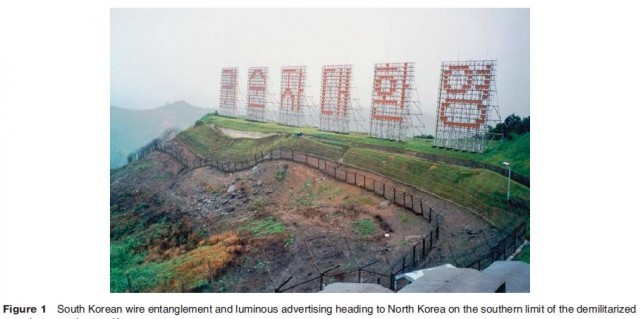The Permeability of Borders
Permeability, the degree of openness of borders, is of crucial importance for people living in borderlands. The twentieth century saw each type of border regime: closed, semipermeable, and permeable. Some border regimes even ceased to exist, at least in one certain respect, for example, in economic terms.
In Europe, the Iron Curtain was experienced as an insurmountable barrier. Inhabitants on both sides of the border lived at dead ends, which meant that no contacts between them were possible, and the state hindered or tightly controlled crossing, which was only possible at specific border crossings. The Iron Curtain separated not only borderlands and century long neighboring populations but also opposing political and economic systems. It symbolized the demarcation between the West and the East. This type of demarcation still exists in other parts of the world. In Korea, for example, contacts between people from North and South Korea (see Figure 1) are still nearly impossible. On the state level, tentative meetings have recently started to overcome the barriers. On the level of the local populations, however, it is unlikely that they will experience an opening of the tightborder regime in the near future.

In other border contexts, control is strict and security tight, although borderlands have also become economically dynamic areas. The US–Mexican border is a case in point, because goods can easily be moved back and forth between the US and Mexico. The Border Industrialization Program (BIP), initialized by the Mexican government in 1965, has shaped this border landscape and its cross border relations: Industrial plants (maquilas) built on the Mexican side of the border guaranteed both lower cost assembly than on the US side and jobs for thousands of people living in the less developed Mexican borderland. Today the well developed Mexican borderland attracts migrant workers from the southern part of the country and Central America. However, the border regime specifically seeks to prevent the free movement of people from the South to the North, thereby ignoring cultural ties, social links, and economic dependence between the local populations, for example, in the twin cities Ambos Nogales in Arizona, USA, and Sonora, Mexico. In contrast to the impact of this strict border regime on cultural and economic ties, it is economic interdependence that affects the population living in and around Melilla and Ceuta, two Spanish cities on the African side of the Straits of Gibraltar. Since the EU erected a high security fence to demarcate the border between Spain and Morocco and to prevent South– North migration, the local populations can no longer interact or continue their traditional trading.
Within Europe, discussions on borders as obstacles to the free movement of goods dominated national discourses for decades. Moreover, the perspective that borders are barriers to mutual understanding between nations resulted in the joint effort of several European states that has become known as 'European integration'. Even when border regimes are tight, efforts are made to facilitate cooperation or at least peaceful coexistence between neighboring communities. In communist times as well, people on the Italian–Yugoslav border were allowed to cross the border with special permits to work on the other side. In the 1990s, the EU started programs to overcome barriers and differences in structures, to compensate for disadvantages pertaining to location and unequal development, and to design border regions that allow the local populations in the borderlands to improve economically and to interact culturally and socially.
In Africa and other contexts, where borders were introduced without taking account of local and traditional situations, borderlands became sites of conflict in the twentieth century – either due to governmental questioning of the border, or state borders not coinciding with cultural borders. Although the asymmetry between the two sides there is also economically determined, it is more often determined by political circumstances that motivate people to flee one side of the border to seek a life of security and peace on the other side. In these borderlands, most people live in refugee camps.
Finally, ecological problems, which do not stop at national borders, very often challenge tight border regimes and borderlands. Borderlands thus face a double burden: A population may face ecological problems produced across the border and then not have access to the required financial and logistical resources to handle these problems effectively. There are few examples where adjacent borderlands have agreed to cooperate in case of ecological catastrophe, and where adjustments to laws have been made on the national level to equalize ecological standards (Figure 2). In most cases, borderlands are the most directly affected, yet least supported areas within states.
